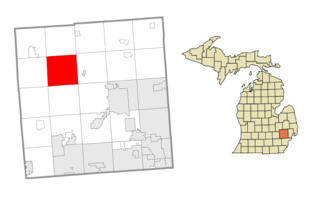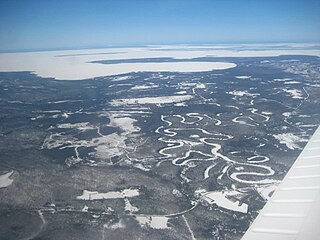
Springfield Charter Township is a charter township of Oakland County in the U.S. state of Michigan. As of the 2020 census, the township population was 14,703. The township was named for the numerous springs in the area.

Avondale is a town located on Newfoundland's Avalon Peninsula in the province of Newfoundland and Labrador, Canada, which was incorporated in 1974. The community is situated at the southwestern head of Conception Bay in Division 1. It is located 59 km (37 mi) southwest of St. John's and 72 km (45 mi) northeast of Placentia.
Badger is a town in north-central Newfoundland, Newfoundland and Labrador, Canada on the Exploits River. It supplied pulp and paper for the mills in Grand Falls for many years and was famous for its large spring log drives. The town is located in the interior of the island, twenty miles west of Grand Falls in Division No. 6. Badger was incorporated as a Town on September 30, 1963.

The Exploits River is a river in the province of Newfoundland and Labrador, Canada. It flows through the Exploits Valley in the central part of Newfoundland.

The Monon Railroad, also known as the Chicago, Indianapolis, and Louisville Railway from 1897 to 1971, was an American railroad that operated almost entirely within the state of Indiana. The Monon was merged into the Louisville and Nashville Railroad in 1971, and much of the former Monon right of way is owned today by CSX Transportation. In 1970, it operated 540 miles (870 km) of road on 792 miles (1,275 km) of track; that year it reported 1320 million ton-miles of revenue freight and zero passenger-miles.

The Newfoundland Railway was a narrow-gauge railway that operated on the island of Newfoundland from 1898 to 1988. With a total track length of 906 miles (1,458 km), it was the longest 3 ft 6 in narrow-gauge system in North America.

Unorganized North Algoma District is an unorganized area in northeastern Ontario, Canada, comprising all areas in Algoma District, north of the Sault Ste. Marie to Elliot Lake corridor, which are not part of an incorporated municipality or a First Nation. It covers 43,618.95 km2 (16,841.37 sq mi) of land, and had a population of 6,050 in 2021. Many of these communities were/are stations on the Algoma Central Railway or were logging/mining towns.
Beothuk Lake, formerly Red Indian Lake, is located in the interior of central Newfoundland in the province of Newfoundland and Labrador, Canada. The lake drains into the Exploits River which flows through the interior of Newfoundland and exits into the Atlantic Ocean through the Bay of Exploits. Lloyds River, the Victoria River and Star River feed into the lake.
Quarry is an abandoned railway community that was located in the Gaff Topsails area of the province of Newfoundland, Canada. The community lies just north of Buchans and takes its name from the quarry established in the 1890s when the Newfoundland Railway was being built.
Gaff Topsail is an abandoned railway settlement located in the interior of Newfoundland, Canada, between the communities of Millertown Junction to the east and Kitty's Brook to the west. The population was entirely composed of railway workers who worked on the Newfoundland Railway and their families.
Buchans is a town located in the central part of the island of Newfoundland in the province of Newfoundland and Labrador. It is situated on the northwest shore of Beothuk Lake on the Buchans River.
King's Point is a town on the north shore of the southwest arm of Green Bay in Newfoundland and Labrador, Canada. King's Point is 24 km (15 mi) by road from Springdale, and 10 km (6.2 mi) from the Trans-Canada Highway.

Robinsons is a village in the Bay St. George area of the Canadian province of Newfoundland and Labrador. "Robinson's Head" has been on maps since about 1798. The headland and community were named after John Robinson from Ireland who lived in a cave in Robinson's Head. "Robinson's Station" about two miles from the original village came into being after the railway was constructed in the late 1890s and people, mainly those working at railway maintenance, settled in the area where the local road intersected the railway. The name "Robinson's Station" became simply "Robinson's" on October 1, 1960. Robinson's had a population of 299 in 1956. "Modern" Robinsons consists of the original Robinson's Head settlement (Robinsons), Robinsons Station, and Robinsons Junction. For census purposes, all three are counted under the "Robinsons" name. The community is located along Route 404.
There are 22 disused railway stations on the Bristol to Exeter line between Bristol Temple Meads and Exeter St Davids. The line was completed in 1844 at which time the temporary terminus at Beambridge was closed. The most recent closure was Tiverton Junction which was replaced by a new station} on a different site in 1986. 12 of the disused stations have structures that can still be seen from passing trains.
The Exploits Valley is a valley in the province of Newfoundland and Labrador in the central part of the island of Newfoundland.
Millertown is a town in the Canadian province of Newfoundland and Labrador on the north-east side of Beothuk Lake. The town had a population of 87 in the Canada 2021 Census.

The Mountain Division is a railroad line that was once owned and operated by the Maine Central Railroad (MEC). It stretches from Portland, Maine on the Atlantic Ocean, through the Western Maine Mountains and White Mountains of New Hampshire, ending at St. Johnsbury, Vermont in the Northeast Kingdom. The line was abandoned in 1983 by MEC's successor, Guilford Transportation Industries (GTI). Guilford retained a stub between Portland and Westbrook. A section in New Hampshire remains in use by heritage railway Conway Scenic Railroad.
Buchans Junction is a local service district and designated place in the Canadian province of Newfoundland and Labrador in the central part of the island of Newfoundland. It is on the banks of Mary March River near where the Mary March River flows into the northeast end of Beothuk Lake. The community is on a site first known as "Four Mile Siding" on the railway which was constructed in 1900 to connect the community of Millertown to the Newfoundland Railway at Millertown Junction. The site itself became a rail junction in 1927 when Asarco subsidiary, the Buchans Mining Company, completed a rail link from the newly formed mining town of Buchans. Ever since 1927, even after the Buchans Railway closed in 1977, the community has been known as "Buchans Junction".

Route 370, also known as the Buchans Highway, is a 73-kilometre-long (45 mi) east–west highway in the central portion of Newfoundland in the Canadian province of Newfoundland and Labrador. Its eastern terminus is the intersection at the Trans-Canada Highway in the Town of Badger, and the route ends at the Town of Buchans.

The Lake Erie and Northern Railway was an interurban electric railway which operated in the Grand River Valley in Ontario, Canada. The railway owned and operated a north–south mainline which ran from Galt in the north to Port Dover on the shore of Lake Erie in the south. Along the way, it ran through rural areas of Waterloo County, Brant County, and Norfolk County, as well as the city of Brantford, where it had an interchange with the Brantford and Hamilton Electric Railway. Construction on the mainline began in 1913. The railway began operations in 1916 as a subsidiary of the Canadian Pacific Railway (CPR), which had purchased the line before construction had finished. In 1931, it was consolidated with the Grand River Railway under a single CPR subsidiary, the Canadian Pacific Electric Lines (CPEL), which managed both interurban railways, though they continued to exist as legally separate entities. Passenger service was discontinued in 1955 but electric freight operations continued until 1961, when the LE&N's electric locomotives were replaced by diesel CPR locomotives and the line was de-electrified. In the same year, service on the mainline from Simcoe to Port Dover was discontinued, but the remainder continued to operate as a branchline which as early as 1975 was known as the CP Simcoe Subdivision. The remainder of the line was officially abandoned in the early 1990s, ending almost seventy-five years of operation.










